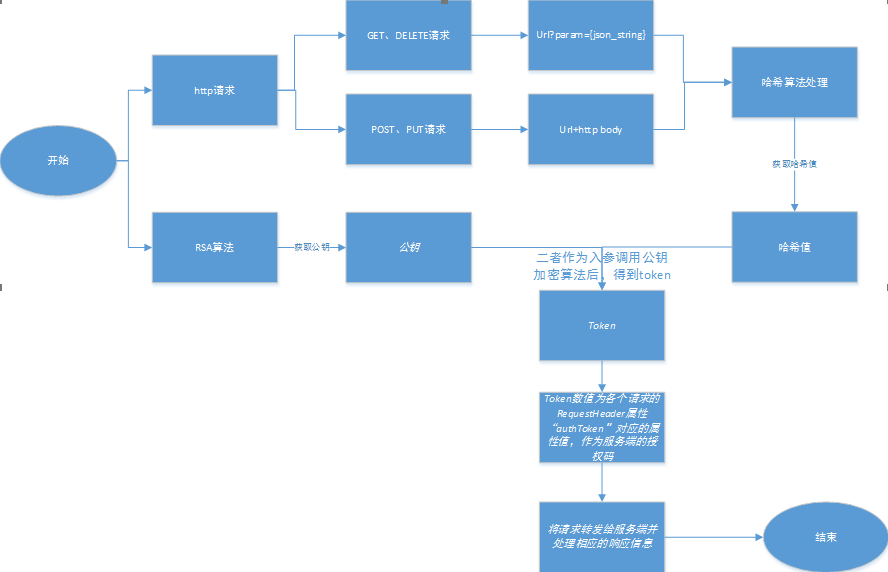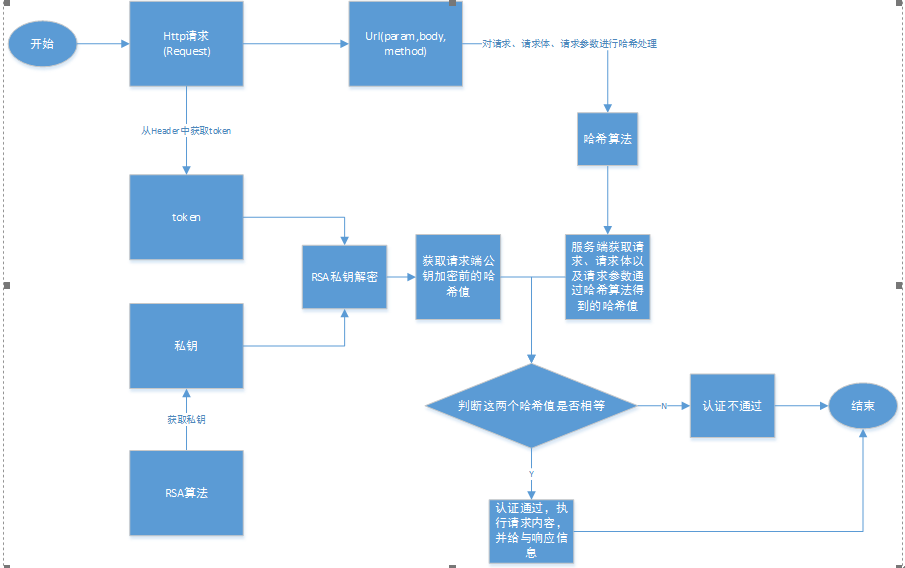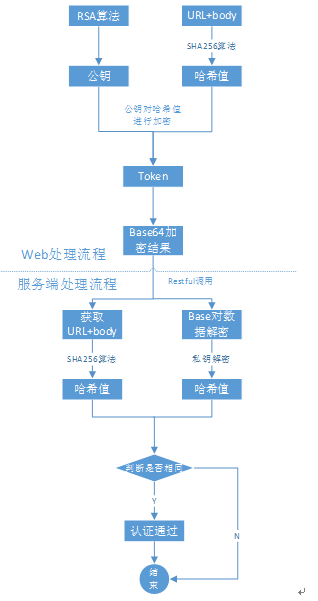RSA+SHA256+BASE64对数据进行加密解密及校验
#需求
需要实现加密的认证机制
##认证原理
a) 密钥分配:RSA算法通过工具或方法调用生成公钥和私钥(1024bit),请求端使用公钥,服务端使用私钥。
b) 加密方式:请求端通过密钥分配获取公钥,根据RSA加密算法将进行哈希后的明文请求进行公钥加密生成token;服务端通过密钥分配获取私钥,根据RSA解密算法将请求端的token进行私钥解密。
c) 认证方式:在服务端,如果明文请求的哈希值和私钥解密后信息的哈希值是一致的,则认为认证成功,完成授权。
d) 数据传输:RSA加密生成的是乱码,为了传输,将数据进行Base64封装,服务端收到之后进行解封装。
##认证流程
a) 请求端的认证流程,如下图所示:

b) 服务端的认证流程,如下图所示:

c) 整体流程

#编码方法的实现
Commons codec,是项目中用来处理常用的编码方法的工具类包,例如DES、SHA1、MD5、Base64,URL,Soundx等等。不仅是编码,也可用于解码。其中MD5/SHA是不可逆算法,BASE64是可逆算法。目前最新版本是1.11。RSA不在commons codec里。
##RSA的实现
import javax.crypto.Cipher;import java.security.*;import java.security.interfaces.RSAPrivateKey;import java.security.interfaces.RSAPublicKey;import java.security.spec.PKCS8EncodedKeySpec;import java.security.spec.X509EncodedKeySpec;import java.util.HashMap;import java.util.Map;public class RSAUtils {/*** 获取公钥的key*/private static final String PUBLIC_KEY = "RSAPublicKey";/*** 获取私钥的key*/private static final String PRIVATE_KEY = "RSAPrivateKey";/*** 随机生成密钥对*/public static Map<String, String> genKeyPair() {// KeyPairGenerator类用于生成公钥和私钥对,基于RSA算法生成对象KeyPairGenerator keyPairGen = null;try {keyPairGen = KeyPairGenerator.getInstance("RSA");} catch (Exception e) {e.printStackTrace();}// 初始化密钥对生成器,密钥大小为96-1024位keyPairGen.initialize(1024,new SecureRandom());// 生成一个密钥对,保存在keyPair中KeyPair keyPair = keyPairGen.generateKeyPair();// 得到私钥RSAPrivateKey privateKey = (RSAPrivateKey) keyPair.getPrivate();// 得到公钥RSAPublicKey publicKey = (RSAPublicKey) keyPair.getPublic();try {// 使用Base64对公钥加密得到字符串String publicKeyString = Base64Utils.encode(publicKey.getEncoded());// 使用Base64对私钥加密得到字符串String privateKeyString = Base64Utils.encode(privateKey.getEncoded());Map<String, String> keyMap = new HashMap<String, String>(2);keyMap.put(PUBLIC_KEY, publicKeyString);keyMap.put(PRIVATE_KEY, privateKeyString);return keyMap;} catch (Exception e) {e.printStackTrace();return null;}}/*** 从字符串中加载公钥* @param publicKeyStr 公钥数据字符串* @return RSAPublicKey 加载出来的公钥* @exception Exception 加载公钥时产生的异常*/public static RSAPublicKey loadPublicKeyByStr(String publicKeyStr)throws Exception {try {byte[] buffer = Base64Utils.decode(publicKeyStr);KeyFactory keyFactory = KeyFactory.getInstance("RSA");X509EncodedKeySpec keySpec = new X509EncodedKeySpec(buffer);return (RSAPublicKey) keyFactory.generatePublic(keySpec);} catch (Exception e) {throw new Exception(e);}}/*** 从字符串中加载私钥* @param privateKeyStr 私钥数据字符串* @return RSAPublicKey 加载出来的私钥* @exception Exception 加载私钥时产生的异常*/public static RSAPrivateKey loadPrivateKeyByStr(String privateKeyStr)throws Exception {try {byte[] buffer = Base64Utils.decode(privateKeyStr);PKCS8EncodedKeySpec keySpec = new PKCS8EncodedKeySpec(buffer);KeyFactory keyFactory = KeyFactory.getInstance("RSA");return (RSAPrivateKey) keyFactory.generatePrivate(keySpec);} catch (Exception e) {throw new Exception(e);}}/*** 公钥加密过程* @param publicKey 公钥* @param plainTextData 明文数据* @return byte[] 加密结果* @throws Exception 加密过程中的异常信息*/public static byte[] encrypt(RSAPublicKey publicKey, byte[] plainTextData)throws Exception {if (publicKey == null) {throw new Exception("加密公钥为空, 请设置");}Cipher cipher = null;try {// 使用默认RSAcipher = Cipher.getInstance("RSA");cipher.init(Cipher.ENCRYPT_MODE, publicKey);byte[] output = cipher.doFinal(plainTextData);return output;} catch (Exception e) {throw new Exception(e);}}/*** 私钥加密过程* @param privateKey 私钥* @param plainTextData 明文数据* @return byte[] 加密结果* @throws Exception 加密过程中的异常信息*/public static byte[] encrypt(RSAPrivateKey privateKey, byte[] plainTextData)throws Exception {if (privateKey == null) {throw new Exception("加密私钥为空, 请设置");}Cipher cipher = null;try {// 使用默认RSAcipher = Cipher.getInstance("RSA");cipher.init(Cipher.ENCRYPT_MODE, privateKey);byte[] output = cipher.doFinal(plainTextData);return output;} catch (Exception e) {throw new Exception(e);}}/*** 私钥解密过程* @param privateKey 私钥* @param cipherData 密文数据* @return 明文* @throws Exception 解密过程中的异常信息*/public static byte[] decrypt(RSAPrivateKey privateKey, byte[] cipherData)throws Exception {if (privateKey == null) {throw new Exception("解密私钥为空, 请设置");}Cipher cipher = null;try {// 使用默认RSAcipher = Cipher.getInstance("RSA");// cipher= Cipher.getInstance("RSA", new BouncyCastleProvider());cipher.init(Cipher.DECRYPT_MODE, privateKey);byte[] output = cipher.doFinal(cipherData);return output;} catch (Exception e) {throw new Exception(e);}}/*** 公钥解密过程* @param publicKey 公钥* @param cipherData 密文数据* @return 明文* @throws Exception 解密过程中的异常信息*/public static byte[] decrypt(RSAPublicKey publicKey, byte[] cipherData)throws Exception {if (publicKey == null) {throw new Exception("解密公钥为空, 请设置");}Cipher cipher = null;try {// 使用默认RSAcipher = Cipher.getInstance("RSA");// cipher= Cipher.getInstance("RSA", new BouncyCastleProvider());cipher.init(Cipher.DECRYPT_MODE, publicKey);byte[] output = cipher.doFinal(cipherData);return output;} catch (Exception e) {throw new Exception(e);}}/*** 获取私钥* @param keyMap 密钥对* @return* @throws Exception*/public static String getPrivateKey(Map<String, String> keyMap)throws Exception {String privateKey = keyMap.get(PRIVATE_KEY);return privateKey;}/*** 获取公钥* @param keyMap 密钥对* @return* @throws Exception*/public static String getPublicKey(Map<String, String> keyMap)throws Exception {String publicKey = keyMap.get(PUBLIC_KEY);return publicKey;}}
##SHA256与Base64实现
commons.codec包有这两个算法的实现,分别如下:
###SHA256
import org.apache.commons.codec.digest.DigestUtils;public class SHA256Utils {/*** sha256加密* */public static String sha256Hex(String data){return DigestUtils.sha256Hex(data);}}
###Base64
import org.apache.commons.codec.binary.Base64;public class Base64Utils{/*** 使用Base64加密字符串* @return 加密之后的字符串* @exception Exception*/public static String encode(byte[] data){Base64 base64 = new Base64();String encodedData = base64.encodeAsString(data);return encodedData;}/*** 使用Base64解密* @return 解密之后的字符串* @exception Exception*/public static byte[] decode(String data){Base64 base64 = new Base64();byte[] decodedData = base64.decodeBase64(data);return decodedData;}}
#Springmvc的实现
当前端对服务端进行调用时,需要在springmvc中编写一个拦截器,实现一个class继承HandlerInterceptorAdapter,并重写preHandle函数,实现如下:
在dispatcher中添加拦截器:
<mvc:interceptors><bean class="com.zyuc.fw.web.util.tokenInterceptor"/></mvc:interceptors>
##拦截器代码实现
import com.commons.common.support.spring.security.SecurityInterceptor;import com.commons.common.utils.PropUtil;import org.slf4j.Logger;import org.slf4j.LoggerFactory;import org.springframework.web.servlet.handler.HandlerInterceptorAdapter;import org.apache.commons.codec.binary.Base64;import javax.servlet.http.HttpServletRequest;import javax.servlet.http.HttpServletResponse;import java.security.interfaces.RSAPrivateKey;import java.util.*;public class tokenInterceptor extends HandlerInterceptorAdapter {private static final Logger logger = LoggerFactory.getLogger(SecurityInterceptor.class);public tokenInterceptor() {}private String getPrivateValues(byte[] decodeByte) throws Exception{String privateKeyString = PropUtil.get("RSA.PrivateKey");RSAPrivateKey privateKey = RSAUtils.loadPrivateKeyByStr(privateKeyString);logger.info("[tokenInterceptor getPrivateValues] : privateKey = %s.", privateKey);//私钥解密byte[] decodedData = RSAUtils.decrypt(privateKey, decodeByte);String token = new String(decodedData);return token;}/** 使用拦截器在客户端访问之前对请求的数据进行校验*/public boolean preHandle(HttpServletRequest request, HttpServletResponse response, Object handler) throws Exception {String token = "";String serviceToken = "";String requestValues = "";String requestUrl = request.getRequestURL().toString();//得到请求的URL地址requestValues += requestUrl;Map params = request.getParameterMap();//得到所有请求的参数Iterator it = params.keySet().iterator();/*获取URL+body的字符串集合*/while(it.hasNext()){String paramName = (String) it.next();String paramValue = request.getParameter(paramName);requestValues += paramName;requestValues += paramValue;}/*获取token,并对token做base64解码*/Enumeration<String> reqHeadInfos = request.getHeaderNames();//获取所有的请求头while (reqHeadInfos.hasMoreElements()) {token = request.getHeader("Authorization");//根据请求头的名字获取token的值break;}/*如果没有添加token,默认不进行校验*/if (null == token) {return super.preHandle(request, response, handler);}byte[] decodeByte = Base64.decodeBase64(token);/*获取私钥解密之后的token值*/token = getPrivateValues(decodeByte);serviceToken = SHA256Utils.sha256Hex(requestValues);if (!serviceToken.equals(token)) {//判断两次的token值是否相同return false;}return super.preHandle(request, response, handler);}}





























还没有评论,来说两句吧...